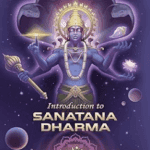Hinduism, also known as Sanatan Dharma, is one of the oldest religions in the world. A wide variety of ideologies, practises, and rites are included in this complex and varied belief system. Sanskrit in origin, the name “Sanatan Dharma” means “the eternal or timeless religion” or “the eternal order.”
Key aspects of Sanatan Dharma (Hinduism) include:
Hindus believe in the cycle of birth, death, and rebirth (samsara), also known as reincarnation. They hold that the soul (atman), which is immortal, travels through this cycle until it is freed from the cycle of reincarnation (moksha).
Karma: The Hindu religion is based on the idea of karma. It is the notion that decisions one makes have an impact on both this life and the one beyond. Positive karma results from good deeds, whilst negative karma results from bad deeds.
Dharma: The term “dharma” relates to one’s obligation, morality, and moral code. Age, caste, gender, and stage of life all have an impact on it. A virtuous existence is viewed as dependent upon living one’s dharma.
The “purusharthas,” or four fundamental pursuits in life, are outlined in Hinduism as the “purusharthas.” These include Moksha (spiritual emancipation), Artha (prosperity/wealth), Kama (pleasure/desire), and Dharma (duty/righteousness). A fulfilling life is thought to require balancing various pursuits.
Hinduism has a long history of yoga and meditation practises that are geared at achieving spiritual development, self-realization, and oneness with the divine. These techniques range greatly and comprise, among others, Hatha Yoga, Bhakti Yoga, Jnana Yoga, and Karma Yoga.
Hinduism is polytheistic, and its pantheon of gods is enormous. Other notable deities include Lakshmi, the goddess of wealth, Saraswati, the goddess of knowledge, and Durga, the goddess of power, in addition to Brahma, the creator, Vishnu, the preserver, Shiva, the destroyer.
Scriptures: The Vedas, Upanishads, Bhagavad Gita, Ramayana, and Mahabharata are only a few of the many sacred scriptures that comprise Hinduism. These writings offer instructions on philosophy, morality, customs, and tales of the gods.
Hinduism is highly diverse, encompassing a vast range of practises and beliefs. It lacks a singular founder and a supreme religious leader. Numerous regional and cultural influences have shaped its evolution over thousands of years.
- Tat Tvam Asi – “That Thou Art” (Chandogya Upanishad): This Upanishadic teaching emphasizes the idea that our true essence, the Atman (individual soul), is not separate from the ultimate reality, Brahman. It teaches the unity of the individual soul with the universal consciousness.
- Aham Brahmasmi – “I am Brahman” (Brihadaranyaka Upanishad): This teaching affirms the identity of the individual self (Atman) with the supreme reality (Brahman), signifying that realizing one’s true nature is recognizing their divine essence.
- Ayam Atma Brahma – “This Self (Atman) is Brahman” (Mandukya Upanishad): The Mandukya Upanishad stresses the unity of the individual self (Atman) and the ultimate reality (Brahman), highlighting that understanding one’s inner self leads to the realization of the divine nature within.
- Sarvam Khalvidam Brahma – “All this, in truth, is the Brahman” (Chandogya Upanishad): This passage underscores the concept that everything in the universe is interconnected and is a manifestation of the supreme reality, Brahman.
- Sanatan Dharma and Its Meaning: Sanatan Dharma, often translated as “eternal religion,” refers to the ancient way of life based on the Vedas and teachings of great Rishis in Bharatvarsha (ancient India). It emphasizes the pursuit of spiritual truths and wisdom.
- Permanence of Brahman: The Upanishads teach that in a world of constant change and impermanence, Brahman is the only permanent and unchanging reality. It is the essence of our soul.
- Purpose of Sanatan Dharma: Sanatan Dharma is a way of life aimed at breaking the illusion of Maya, which generates desires for worldly objects. It teaches that performing actions selflessly, without attachment to outcomes (as explained in the Bhagavad Gita), leads to spiritual progress and liberation.
- Shattering the Divide between Paramatma and Jeevatma: The practices of Sanatan Dharma are powerful tools to bridge the gap between the supreme soul (Paramatma) and the individual soul (Jeevatma).
- Worship of Nature and the Divine: In ancient times, sages worshiped the manifestations of Mother Nature and the five elements, recognizing the presence of the divine in all tangible and visible objects in the universe.
- Hinduism as an Extension of Sanatan Dharma: Hinduism is seen as an extension of Sanatan Dharma, offering diverse spiritual practices, including idol worship, to suit the diverse temperaments of people. The goal is to help individuals realize the oneness of creation and the unity of the worshiper and the deity.
It’s crucial to remember that Hinduism is not a single, unified religion and that various sects and schools of thought within it may place emphasis on different facets of these practises and beliefs. It has also significantly influenced Indian culture, art, and philosophy. Millions of people around the world still follow this vibrant and dynamic religion.







